Cancer is the leading cause of death worldwide. Cancer is a disease in which a few cells in the body go rogue and create havoc. These cells don't want to play by the rule book. Instead, they create colonies of their own in which cells multiply rapidly and form a tumour.
A brief look into the cancer stem cells
But, not all cells within the tumour colony are the same. The unorganised-looking growth called a tumour has an intricate hierarchy and organisation of cells, just like other organs in the body. If organs in the body are cities and cancer cells are rebels, then a tumour is an unauthorised city of rebels. The cities which are not supposed to be there on the map. Nevertheless, at the top of the hierarchy inside this unauthorised city are cancer stem cells (also known as cancer-initiating cells) 1.
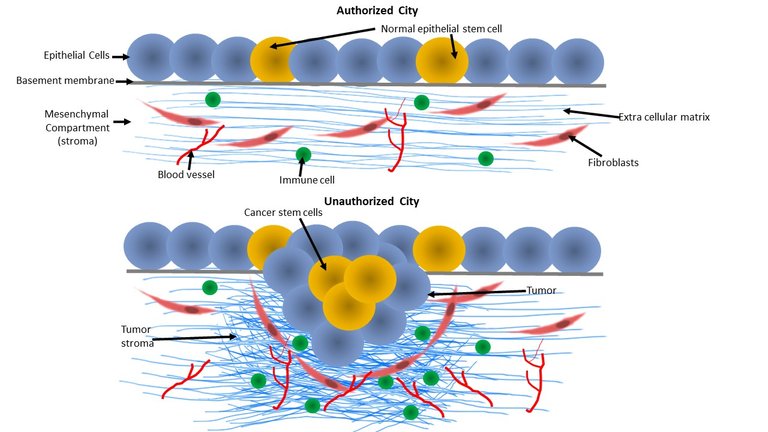
Illustration showing the organisation of different cells types including stem cells in normal tissue (top panel; authorized city) and tumor (bottom panel; unauthorized city). Illustrated by @scienceblocks and @mycrimsonhues
Unlike the ferociously dividing cells in the tumour, the cancer stem cells are rather quiet. They don't divide as much. Of the billions of cells in the tumour, there are only a few cancer stem cells that hold the capability of initiating new tumours. Cancer stem cells give rise to initial cancerous growth (the primary tumour). The same cancer stem cells also travel to a new site and form a secondary tumour (hence spreading cancer through the body). In addition, cancer stem cells are also resistant to most chemotherapy drugs. For instance, most chemotherapy drugs target rapidly multiplying cells in cancer, but cancer stem cells are not rapidly dividing. In addition, cancer stem cells also contain multiple other molecules which help them actively resist therapeutic interventions 2. Therefore, these cells are responsible for the recurrence of the cancers 5 years after doctors thought they had ridden the body of the tumours they found 3
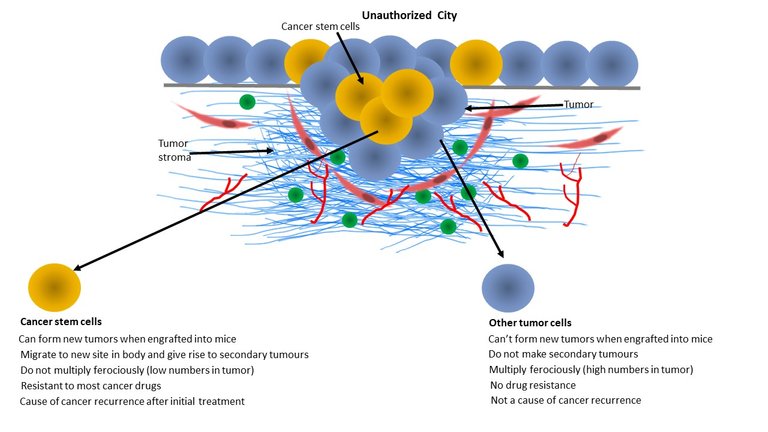
Illustrated by @scienceblocks and @mycrimsonhues
Thus, it is pretty obvious that if we want to fight cancer we need to fight the cancer stem cells as well. One way to do so is to understand why and how cancer stem cells are maintained in their stem cell-like state. And this is what the paper4 recently published by Badarinath et al., in the Cell Reports, from Colin Jamora's lab at Bangalore (in which I am a co-author) talks about. The paper has identified the molecular mechanism by which cancer stem cells maintain their stem-like state.
The findings and take-home message
The paper identified a protein called Snail (produced by gene SNAI1), which is required for the maintenance of a stem-like state in the cells. (Warning: this has nothing to do with the organism called Snail) It has been well documented that expression of this protein Snail is correlated with a higher abundance of cancer stem cells and even spreading of cancer 5, 6. Expression of the Snail protein and higher abundance of cancer stem cells is also correlated with poor response to therapy 7 and decreased survival of patients 8. Nevertheless, it was not known how Snail aid in the maintenance of the cancer stem cells.
[Badarinath et al.]((https://pubmed.ncbi.nlm.nih.gov/36130502/) identified the mechanism by which Snail induces this stem-like state in the cells. Authors found that Snail expressing cells express and secrete a protein called Mindin. Mindin was necessary and sufficient to induce stem cell-like properties in the cells it came in contact with. The authors also identified the molecule on the cell surface (the receptor) to which Mindin binds to relay its effects. In addition, the paper also shows the molecular pathway that Mindin activated downstream of its receptor Integrin alpha M to induce the stem cell-like state in the cells. In a nutshell, Mindin binds to Integrin alpha M, which then activates proteins called the Src family of kinases (SFKs) inside the cells. SFKs then activate another protein called STAT3. STAT3 then leads to the expression of other genes required for stem cell maintenance. Overall the paper identified multiple molecular targets that can be used to therapeutically target cancer stem cells.
How and what - the details
Using skin as the model system
Skin is one of the most accessible organs, and its hierarchy is well understood. Our skin is made up of 3 layers of tissue. The first one is an epithelial layer called the epidermis. The epidermis is made of cells known as keratinocytes. The second one is a layer of soft tissue known as the dermis. The dermis is the mesenchymal compartment and is made up of lots of collagen protein and collagen-producing cells called fibroblasts. And the third is the fat layer composed of fat cells. The epidermis itself is composed of multiple layers of keratinocytes. The bottom layer (stratum basale) rests above the basement membrane and also contains stem cells which can give rise to cells of all layers of the epidermis. The next layer is stratum spinosum, followed by stratum granulosum, and stratum lucidum. Finally, what our eyes can see on the outside is a layer of highly cornified dead cells called stratum corneum.
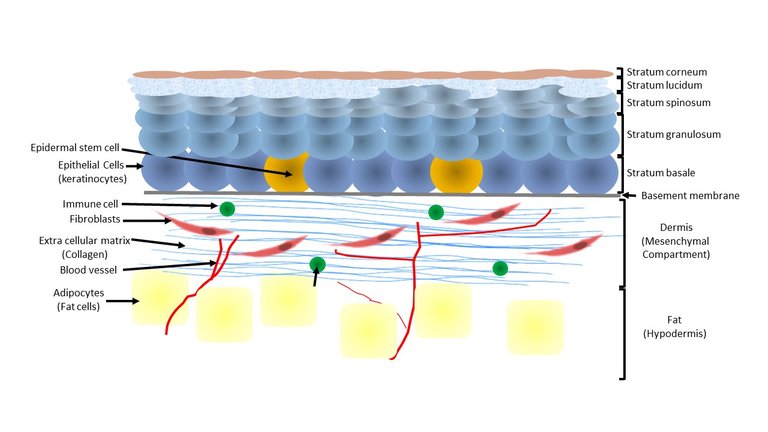
Illustrated by @scienceblocks and @mycrimsonhues
Now, Snail is a protein is which is not usually expressed in any of these layers. It is either expressed during embryonic stages, developmental context, tissue repair, or in cancers. In 2004, Jamora et al. was trying to understand the role of Snail in hair follicle development 9. For this, they developed a mouse model in which Snail was expressed in the basal layer of the epidermis (stratum basale) and hair follicles. Now, apart from hair follicle development these mice also developed a pro-tumorogenic environment in the skin 10. It was much easier to form tumours in this Snail transgenic mice. Why so?
This is what Badarinath started exploring in 2013. At that time it was already known that Snail is overexpressed in cancer stem cells. However, most people thought that the role of Snail in cancer stem cells is to promote a phenomenon known as epithelial to mesenchymal transition. In this phenomenon, epithelial cells transform into mesenchymal fibroblast-like cells, which help form the tumour stroma and also gain higher motility. These highly mobile cells can then spread cancer to different parts of the body. Nevertheless, this phenomenon has never been observed inside the body beyond the embryonic stage. And neither the Snail transgenic mice showed any signs of EMT. So then why was there a higher probability of developing cancers in Snail transgenic mice?
This unwarranted expression of Snail in the cells prolonged their stem cell-like state. Snail transgenic mice have more stem cells in their epidermis when compared to regular mice. The Snail-expressing cells also overexpressed the Yamanaka factors (the markers of stem cells). Inserting the Snail gene in a regular epithelial cell (extracted from the normal epidermis), gave it stem cell-like properties in a tissue culture dish. And, when you take these Snail expressing cells either from the snail transgenic mice or from the tissue culture dish and inject them in the mouse, they form larger tumours. You can also do the same thing with cells from human tumours. You can take the cells with higher expression of Snail and inject them into mice. The cells with higher levels of Snail formed larger tumours compared to cells with lower expression of Snail. But this makes you wonder - how does the Snail achieve this? How does this gene keep the regular epithelial cell in the stem-like state which promotes tumour formation?
When we looked closely, we found that Snail expressing cells secrete a bunch of unique proteins. And one such unique protein was Mindin, aka Spondin2 (expressed by a gene called SPON2). Mindin has been previously shown to be overexpressed in many cancers. In fact, it is not only overexpressed but has also been proposed as a potential marker for the diagnosis of cancers. In addition, the level of Mindin also seems to predict the outcome for the patients (a prognostic biomarker). In addition, deleting Mindin from mice reduced the number of stem cells in the Snail transgenic epidermis. So it was obvious to ask if the Snail-Mindin axis has anything to do with the stem-like state of the epithelial cells.
So we purified a recombinant version of Mindin protein and treated the regular skin epithelial cells with Mindin. The Mindin-treated epithelial cells displayed the same stem-like properties as was observed in Snail-expressing cells. The Mindin treatment was sufficient to induce the expression of Yamanaka factors and keep these cells in a stem-like state. Furthermore, deleting Mindin from snail-expressing cells or cells of human tumours led to a significant reduction in the size of tumours formed. This indicated that the stem-cell maintenance effect of Snail was mediated by Mindin. But how did Mindin achieve this at the molecular level?
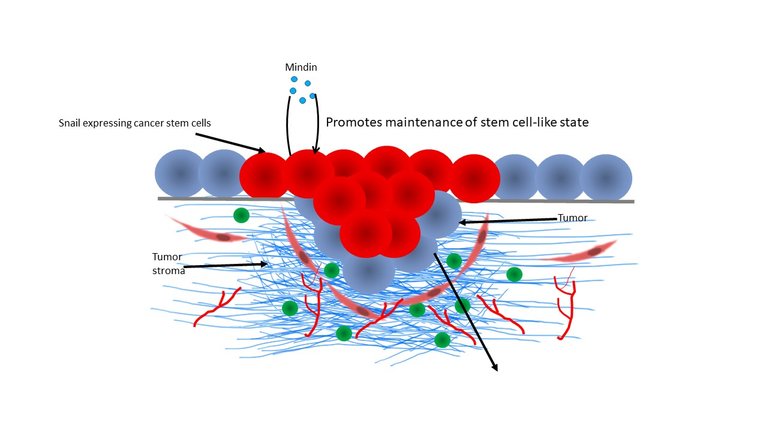
Illustrated by @scienceblocks and @mycrimsonhues
Badarinath et al. showed that Mindin secreted by the Snail expressing cells acts via a cell receptor known as integrin alpha M. Now, Integrin alpha M has been shown to be expressed on cells of the innate immune system - macrophages, neutrophils, etc. But surprisingly, we found that it was also expressed in low levels on some epithelial cells. And the presence of these receptors in low levels was sufficient to activate a downstream signalling cascade of Src family kinases-JAK-STAT3. This cascade was crucial for the maintenance of a stem-like state in the cells.
Overall, this work provides a multitude of targets to develop a therapy for targeting cancer stem cells.
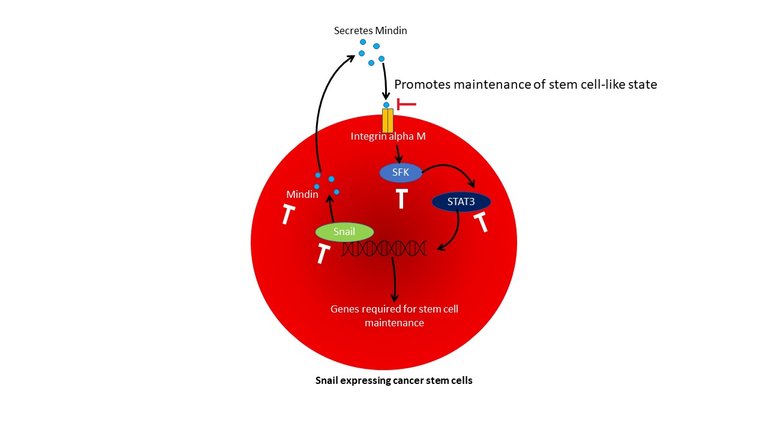
Illustrated by @scienceblocks

Hive#STEMsocial powered by
Video by @gtg
References
Cancer Stem Cells (CSCs) in Drug Resistance and their Therapeutic Implications in Cancer Treatment
Cancer stem cells. Role in tumor growth, recurrence, metastasis, and treatment resistance
Snail Contributes to the Maintenance of Stem Cell-Like Phenotype Cells in Human Pancreatic Cancer
Snail is an independent prognostic predictor for progression and patient survival of gastric cancer
A Signaling Pathway Involving TGF-β2 and Snail in Hair Follicle Morphogenesis
About contacting me
You can reach out to me on discord if you are in stemsocial discord. Or you can even send me a DM. My discord handle is the same as my hive - @scienceblocks. You can also ping me on my telegram handle: @UncertainHeisenberg. Or follow me on Twitter: @scienceblocks1
I have added @mycrimsonhues and @gtg as 1% beneficaries as token of thanks for helping with the illustrations and stemsocial video used in this post, respectively.
Very Interesting and nice illustrations
!1UP
Thank you
Thanks for your contribution to the STEMsocial community. Feel free to join us on discord to get to know the rest of us!
Please consider delegating to the @stemsocial account (85% of the curation rewards are returned).
Thanks for including @stemsocial as a beneficiary, which gives you stronger support.
I gifted $PIZZA slices here:
(13/20) @curation-cartel tipped @scienceblocks (x1)
Join us in Discord!
This is a refreshing read, love the nice illustration used. Makes the reading much more interesting and comprehensible.
Thanks. Glad you enjoyed.
You have received a 1UP from @gwajnberg!
@stem-curator
And they will bring !PIZZA 🍕. The @oneup-cartel will soon upvote you with:
Learn more about our delegation service to earn daily rewards. Join the Cartel on Discord.